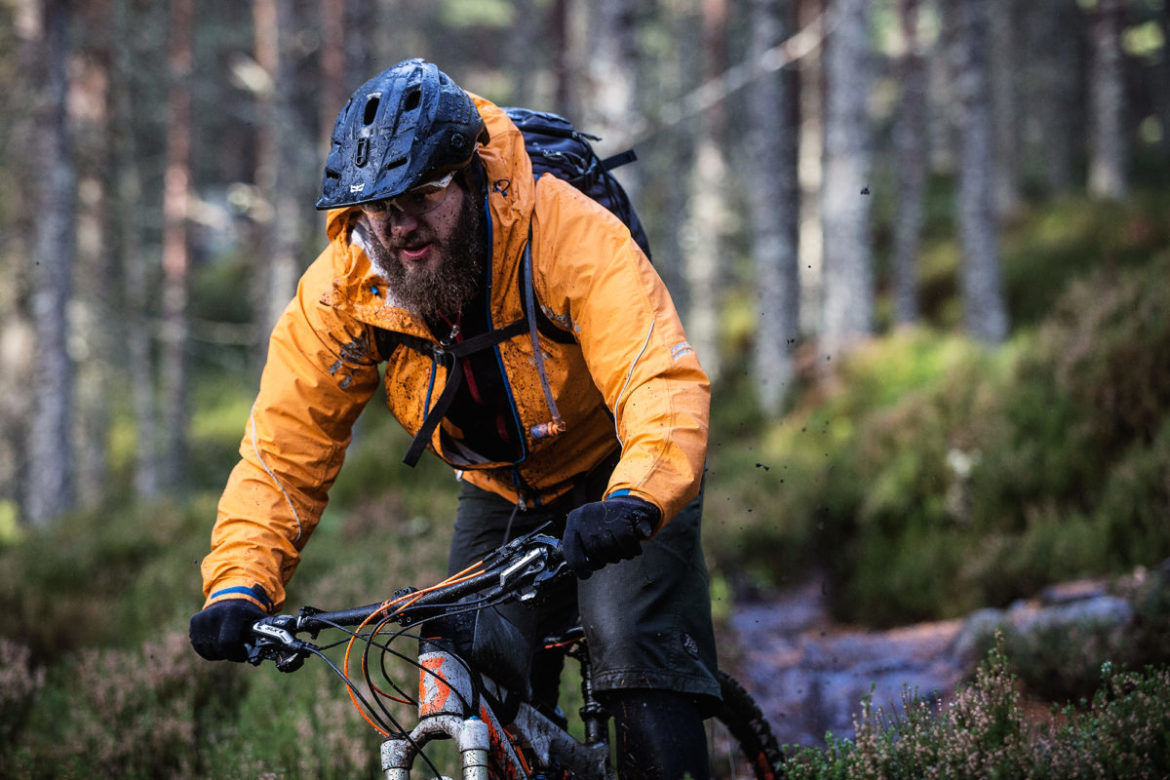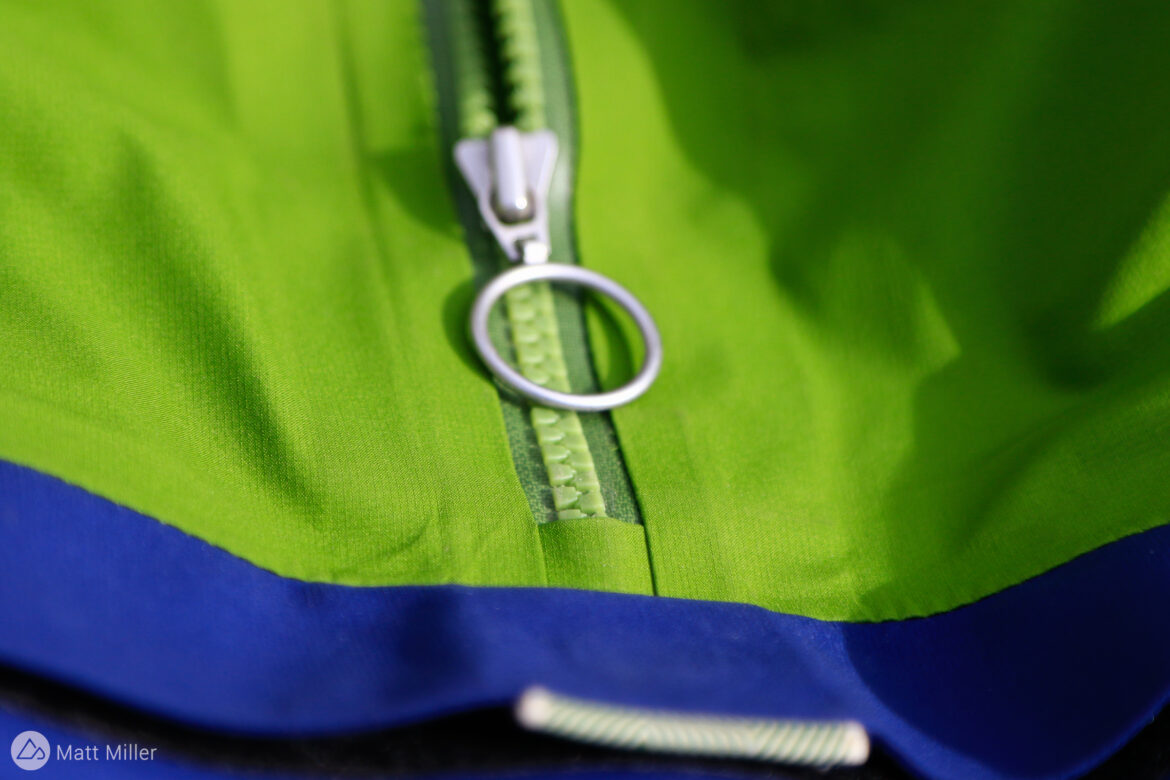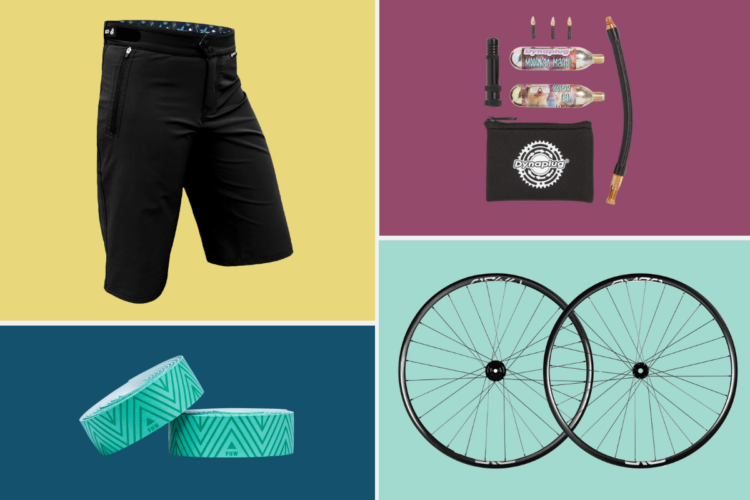
Rain jackets are consistently one of the most expensive wearables we test at Singletracks. For this test of waterproof rain jackets first published early in 2022, the average price was $280, with a range of price points, from $169 to $449. Unsurprisingly, and understandably, the first comments we hear are usually “Holy crap these are expensive,” or “No way in hell.”
It might also be unsurprising to know that our testers have given more applause to the pricier garments for their performance in serious wet weather conditions, for their breathability, fit and durability. But that still does little to tell us why good rain jackets cost as much as they do and what goes into the unassuming, high-tech fabrics. So, we called up some folks at leading apparel brands Endura, Pearl Izumi, and Rapha to learn more than we ever expected about rain jackets.
What makes a good mountain biking rain jacket?

It doesn’t take much to make a rain jacket that keeps the wearer dry. A trash bag with a hole cut in the top will meet that objective. But to make a garment that keeps water out, lets moisture escape from the inside, and lets air in is a different story.
Endura starts out with who the jacket is made for.
“It’s always a bit of a balance of who it’s aimed at and the price point you’re aiming for,” said Ian Young, Endura’s category manager. But, looking closer at how a mountain biker’s rain jacket might differ from a hiker’s, it does get more complex. After all, most of us would agree the demands of mountain biking are quite different from hiking.
“From a cycling point of view, we put a lot of emphasis on breathability and temperature regulation, but also the kind of waterproofing of the fabric,” said Young.
Representatives from Pearl Izumi, Endura, and Rapha emphasized that water proofing and resistance happens through sourcing the right type of fabric for the jacket’s intent and price point. That happens through picking the right type of membrane and their preferred type of water resistant coating on the outer layer, but there are also two other elements that are hugely important:
“Our opinion is that it’s not waterproof unless it’s fully seam sealed,” said John Pepper, the senior line product manager for Pearl Izumi. Rain jackets can’t be stitched together like a pair of jeans. Instead, brands use a seam tape for a water tight bond.
The other important piece is zippers. Rain jacket designers use storm flaps or waterproof zippers in place of traditional zippers to keep water out of the parts that open the rain jacket to the elements.
There are infinite options to design a good jacket

Generally, it takes longer to stitch and tape fabric together, which makes them more expensive than other garments. But the unique fabrics that high-end brands use come at a cost too.
“The way the cost of a garment is generally built, you tend to find that about 30% of the cost comes from materials, about 30% of the cost comes from the make or physically constructing the garment together and the rest is secondary materials like zips, trims, stitching, etc,” said John Roberts, the product director of Rapha. Those costs compound during construction.
“The materials cost more but it’s how you construct and seal the garments where it’s a lot more work that goes into creating a product that is fully waterproof and windproof, for example,” said Roberts.
On certain rain jackets where brands like Rapha source materials from another brand, like GoreTex, the costs can add up quickly because of the back-and-forth nature the product requires. GoreTex sends Rapha fabric, Rapha builds a prototype rain jacket and then sends it back to GoreTex to meet their waterproof testing standards. While this adds to the overall cost of the piece, there is obviously a lot of credibility built into the GoreTex brand from decades of research and development.
Rapha uses GoreTex on its top-shelf rain jacket, but it does offer less expensive rain jacket options without the fabric. Before we get farther though, we need to elaborate on rain jacket construction.

“The really important thing about waterproof fabrics is they are like a sandwich,” said Young from Endura. “There are three layers of fabrics or three layers of material laminated into what feels like a single fabric.”
Rain jackets usually come in one of three builds: A 2-layer, a 2.5-layer, and a 3-layer. Two-layer jackets have a membrane attached to an outer fabric which makes it more durable. These may have a hanging liner on the inside so the membrane isn’t resting on sweaty skin, but these liners add weight too.
A 2.5-layer jacket has a waterproof coating on the underside of an outer shell and then it will have a protective coating or half layer on the outside. These tend to be more affordable than 3-layer jackets which are typically flagship models featuring GoreTex. Three-layer jackets have a waterproof/breathable membrane sandwiched between a fabric layer on the inside for comfort and membrane protection, and then a durable layer on the outside of the membrane. Even with three layers, these jackets feel very thin and light.

Brands can tweak these layers and materials in many ways. Some might source high-end fabrics like GoreTex or PolarTec or use their own proprietary fabrics.
Endura uses their own materials, Pearl Izumi uses their own like PI Dry, but also uses PolarTec, and Rapha develops their own materials but also uses GoreTex on some jackets.
“That’s why there’s so much variability in price and performance,” said Young, “because you can change each one of those layers for hundreds of different options to achieve what you’re looking for.”
For Pearl Izumi, the cost equation is simple. “It’s all about the material really,” said Pepper. “As the price goes up, breathability goes up.”
On one of the brand’s latest jackets they use NeoShell from PolarTec, an electrospun membrane. Pepper said it’s spun like cotton candy to make interlocked fibers that let moisture vapor and heat travel in and out of the fabric without the user having to get warm to create a pressure difference in the jacket and allow air to move through the membrane.
“It’s just hard to manufacture,” he said of the NeoShell fibers. “It’s hard to get it stable and consistent across the entire thing.”
Honestly, what are the differences in a low-end versus high-end jacket?

Getting back to the trash bag example, breathability is usually the biggest difference between a low-end and high-end rain jacket. Pearl Izumi’s most expensive jacket uses NeoShell, said to enhance breathability in any conditions, and waterproof zippers instead of storm flaps.
The Pearl Izumi Summit Pro NeoShell WxB jacket has multiple waterproof zippers, features “the world’s most breathable waterproof material,” and retails for $375. Compare that to the brand’s $175 Summit 3L WxB jacket, which has just one waterproof zipper and a lower, 10K/10K water resistant/breathability rating. (Ratings like this mean a fabric can block 10,000mm of water in a square inch column pressure test. The second number is the breathability measurement, which quantifies how many grams of water vapor is transferred from the inside of a fabric to the outside across a square meter in a 24-hour period.)
Young from Endura explained that their brand sees the differences in low- and high-end jackets depending on the use. For someone commuting to work in the rain on a flat bike path, they might not notice the difference in breathability. But, if that commute got rocky and slick and the rider had to work a lot harder, they probably would.
“It will all keep you dry, but if you are working hard in that jacket, or you’re out all day in it, or you’re riding every day, all winter, then you will get much better performance out of the high-level jackets than you will from our low-end jackets.”
Young explained they believe that zippers are a part of the solution too and their preferred method for staying cool inside of a rain layer.
“Temperature regulation is best done by—if you’re too hot, you unzip the jacket or unzip some vents,” said Young. Yes, it costs more money to add zippers, but the ventilation is instantaneous.
How to get the most out of your rain jacket

There are few things more frustrating than buying a pricey new layer only to have it tear at the seams or wear out prematurely. Roberts of Rapha said, “There are two elements where jackets tend to fail or where you need to pay more attention.”
The first is the DWR coating, the durable water repellent that rain jacket exteriors are treated with, and the second is the seam taping that can wear with regular use.
DWR coatings wash off over time and washing rain jackets is encouraged since it keeps sweat and debris off of the membrane, helping it breathe and expel moisture. Young of Endura also mentioned that newer coatings that are better for the environment wear more quickly and need proofed more frequently.

Re-proofers like Nikwax and Granger are readily available in spray and detergent forms. Jackets typically shouldn’t be dried on high heat though because it can damage the membrane and seams. Fortunately, brands like Rapha include patches on their garments to repair tears and people can send garments in for repair to keep them going.
Rapha, like the other brands, said they don’t have a benchmark for how long a good rain jacket should last. Like other brands, durability starts with selecting a heavier material for their mountain bike jackets than their road cycling rain jackets to prevent tears from crashes and snags. In the end, making the jacket last is up to the wearer.
“It all depends on how often the jacket is used and how people treat the jacket.”
















